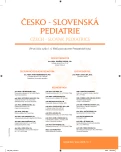Somatic development of the child and injury incidence during the pubertal spurt – new knowledge of the correlation between growth dynamics and injury risk in the present population of children
Authors:
S. Janoušek 1; P. Sedlák 2; L. Kukla 3; Z. Roth 1; J. Vignerová 4; Z. Zvadová 4; V. Faierajzlová 4
Authors‘ workplace:
Státní zdravotní ústav, Centrum laboratorních činností, Prahavedoucí MUDr. D. Jírová, CSc.
1; Katedra antropologie a genetiky člověka, Přírodovědecká fakulta Univerzity Karlovy, Prahavedoucí doc. Mgr. V. Sládek, Ph. D.
2; Výzkumné pracoviště preventivní a sociální pediatrie, Lékařská fakulta Masarykovy univerzity, Brno vedoucí doc. MUDr. L. Kukla, CSc.
3; Státní zdravotní ústav, Centrum podpory veřejného zdraví, Prahavedoucí MUDr. M. Nejedlá
4
Published in:
Čes-slov Pediat 2013; 68 (1): 20-35.
Category:
Original Papers
Overview
Injuries and their consequences pose serious health, social and economic concerns. Based on the data of the Institute of Health Information and Statistics of the Czech Republic (IHIS), the overall child injury incidence rate increased year over year by 0.7% and the number of fractures rose year over year by 1.3% in the Czech Republic in 2000–2005. In comparison with the previous decade, the child injury incidence rate increased by 8% and the fracture incidence rate per 100,000 children was nearly 10% as high. In 2006–2009, a downward trend in the injury incidence was observed (394 thousand injuries on average were reported annually in children 0–14 years of age, i.e. 266 injuries per 1000 children per year) [1]. In children under 15 years of age, fractures account for about 25% of the overall injury incidence on a long-term basis. During the pubertal spurt, fracture is the leading cause of injury.
The usefulness and benefit of the new data from the semi-longitudinal study of somatic development and injury incidence in school children are discussed and a close association is reported between the growth profile and injury incidence in early adolescence. The new data contribute to a new insight into the higher injury risk during the pubertal spurt. The data from the semi-longitudinal survey could be considerably helpful in pediatric and pedagogical practice for solving the current tasks in child injury prevention, for identifying the effective child injury prevention strategies to be implemented in primary schools and thus for significantly reducing the injury incidence in the present population of school children.
Key words:
child injury incidence, somatic development of the child, growth rate curves, semi-longitudinal study, pubertal spurt
Sources
1. ÚZIS ČR. Aktuální informace č. 24/2011. Úrazovost dětí a mládeže do roku 2009.
2. ÚZIS ČR. Aktuální informace č. 29/2010. Činnost chirurgických oborů v ambulantní péči v roce 2009.
3. ÚZIS ČR. Aktuální informace č. 26/2009. Činnost chirurgických oborů v ambulantní péči v roce 2008.
4. Janoušek S, Sedlak P, Zvadová Z, et al. Epidemiologie nefatálních úrazů a vývoj dětské úrazovosti v posledním desetiletí v České republice. Změna v dosavadním trendu? Čes-slov Pediat 2010; 65 (4): 167–178.
5. Janoušek S, Kukla L, Sedlak P, et al. Dětská úrazovost v České republice v období let 2009 a 2010. Čes-slov Pediat 2011; 66 (3): 157–168.
6. Pelech L, Zvadová Z, Roth Z. Úrazovost dětí mladšího školního věku. Čs Pediat 1996; 51 (12): 755–724.
7. Pelech L, Roth Z, Tošovský V, Zvadová Z, Syrovátka A. Úrazová incidence u starších školních dětí. Čs Pediat 1998; 53 (3): 156–158.
8. Pelech L, Roth Z, Zvadová Z, Andělová Š. Analýza úrazovosti dospívající mládeže. Čs Pediat 1999; 54 (10): 556–561.
9. Zvadová Z, Janoušek S, Roth Z. Incidence úrazovosti u dětí předškolního věku. Čes-slov Pediat 2001; 56 (6): 349–354.
10. Pelech L, Roth Z. Školní a dospívající mládež a dopravní úrazovost. Hygiena 1998; 43 (3): 141–146.
11. Janoušek S, Zvadová Z, Roth Z. Socioekonomická podmíněnost dětské úrazovosti. Čes-slov Pediat 2007; 62 (3):123–132.
12. Janoušek S, Sedlak P, Zvadová Z, et al. Úrazovost u žáků mladšího a staršího školního věku. Rizika fraktur a luxací ve vztahu k pohlaví a vývoji dítěte. Čes-slov Pediat 2007; 62 (12): 655–663.
13. Kutílek S, Bayer M. Osteoporóza v dětském věku. Forum Medicinae 2000; 4: 45–48.
14. Bass S, Delmas PD, Pearce G, Hendrich E, Tabensky A, Seeman E. The differing tempo of growth in bone size, mass, and density in girls is region-specific. J Clin Invest 1999; 104 (6): 795–804.
15. Clark EM, Tobias JH, Ness AR. Association between bone density and fractures in children: a systematic review and meta-analysis. Pediatrics 2006; 117: e291–e297.
16. Kalkwarf HJ, Zemel BS, Gilsanz V, et al. The bone mineral density in childhood study: bone mineral content and density according to age, sex, and race. J Clin Endocrinol Metab 2007; 92 (6): 2087–2099.
17. Gilsanz V, Kovanlikaya A, Costin G, et al. Differential effect of gender on the size of the bones in the axial and appendicular skeletons. J Clin Endocrinol Metab 1997; 82: 1603–1607.
18. Rauch F, Schoenau E. Changes in bone density during childhood and adolescence: an approach based on bone’s biological organization. J Bone Miner Res 2001; 16: 597–604.
19. Kontulainen SA, Macdonald HM, McKay HA. Change in cortical bone density and its distribution differs between boys and girls during puberty. J Clin Endo-crinol Metab 2006; 91 (7): 2555–2561.
20. Sedlak P, Bláha P, Jiroutová L, et al. Využití růstových modelů ke konstrukci rychlostních křivek somatických znaků na základě dat semilongitudinální studie. Čes-slov Pediat 2007; 62 (3): 133–145.
Labels
Neonatology Paediatrics General practitioner for children and adolescentsArticle was published in
Czech-Slovak Pediatrics

2013 Issue 1
Most read in this issue
- A massive pulmonary embolism as a first symptom of nephrotic syndrome in 18-years old female patient
- Importance of early diagnostics of inherited metabolic disorders in neonatal age
- Somatic development of the child and injury incidence during the pubertal spurt – new knowledge of the correlation between growth dynamics and injury risk in the present population of children
- Analysis of risk factors concerning suicidal behavior in childhood and adolescence
